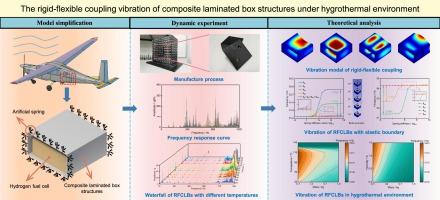The rigid-flexible coupling vibration of composite box structure in new energy hydrogen-electricity aircraft with complex circumstance: Theoretical formulation and experiment
IF 7.9
1区 工程技术
Q1 ENGINEERING, MECHANICAL
引用次数: 0
Abstract
This literature contributes to a theoretical formulation to insight into the rigid-flexible coupling vibration of composite laminated box structures (RFCLBs) in new energy hydrogen-electricity aircraft suffering from complex environments. To achieve this target, a creationary mass model distributed on the interface of the thin-walled box structures is utilized to simulate the RFCLBs by the simplified material coefficient matrix. Based on the Rayleigh-Ritz theory, the dynamic equations of RFCLBs in hygrothermal environments are derived. Owing to rigid mass, four novel vibration patterns which are different from traditional thin-walled box structures have been discovered. More specifically for the new vibration models, a series of theoretical and experiment investigations have been carried out to insight the forming and evolution mechanism of RFCLBs by considering the influence of various masses, sizes and hygrothermal environments in detail. The results indicate that the inherent characteristic of RFCLBs is sensitive to the mass of the rigid component. Under varying external excitations, the modal shapes of RFCLBs exhibit randomness contingent upon specific boundary conditions and their respective order. Additionally, temperature exerts a more pronounced effect on frequency than humidity, which might lead to some unpredictable vibration modes.

复杂环境下新能源氢电飞机复合材料箱体结构的刚柔耦合振动:理论推导与实验
这篇文献为深入研究新能源氢-电飞机复杂环境下复合材料层压箱体结构(RFCLB)的刚-柔耦合振动提供了理论依据。为实现这一目标,利用分布在薄壁箱体结构界面上的创造性质量模型,通过简化的材料系数矩阵来模拟 RFCLB。基于 Rayleigh-Ritz 理论,推导出了 RFCLB 在湿热环境下的动态方程。由于刚性质量的存在,发现了四种不同于传统薄壁箱体结构的新型振动模式。特别是针对新的振动模式,我们进行了一系列理论和实验研究,通过详细考虑各种质量、尺寸和湿热环境的影响,深入了解了 RFCLB 的形成和演化机理。结果表明,RFCLBs 的固有特性对刚性部件的质量非常敏感。在不同的外部激励下,RFCLB 的模态形状表现出随机性,取决于特定的边界条件及其各自的顺序。此外,温度对频率的影响比湿度更明显,这可能会导致一些不可预测的振动模式。
本文章由计算机程序翻译,如有差异,请以英文原文为准。
求助全文
约1分钟内获得全文
求助全文
来源期刊

Mechanical Systems and Signal Processing
工程技术-工程:机械
CiteScore
14.80
自引率
13.10%
发文量
1183
审稿时长
5.4 months
期刊介绍:
Journal Name: Mechanical Systems and Signal Processing (MSSP)
Interdisciplinary Focus:
Mechanical, Aerospace, and Civil Engineering
Purpose:Reporting scientific advancements of the highest quality
Arising from new techniques in sensing, instrumentation, signal processing, modelling, and control of dynamic systems
 求助内容:
求助内容: 应助结果提醒方式:
应助结果提醒方式:


